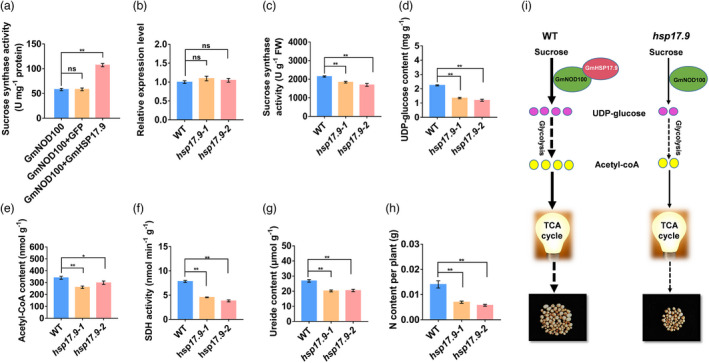Figure 7.

Effect of GmHSP17.9 and GmNOD100 interaction on nodulation and plant growth. (a) Sucrose synthase activity of recombinant GmNOD100. Recombinant GmNOD100 proteins were incubated in the presence or absence of GmHSP17.9, and then the sucrose synthase activity was measured. (b) Expression of GmNOD100 in nodules of hsp17.9 plants at 28 dpi. The relative expression value was normalized based on the expression of GmActin11 (Glyma.18g290800) used as reference gene. ns: not significant. Sucrose synthase activity (c), content of the UDP‐glucose (d), content of acetyl‐CoA (e) and activity of succinate dehydrogenase (SDH) (f) in nodules at 28 dpi. Content of ureide (g) and N (h) of the whole plants at 28 dpi. Values are means of 10 independent plants. Error bars represent means ± SE values. Statistics data were derived from three biological replicates (P < 0.05, t‐test). (i) A proposed model of the regulatory pathway of the interaction between GmHSP17.9 and GmNOD100 in soybean nodulation. When GmHSP17.9 interacts with GmNOD100, sucrose synthase activity of GmNOD100 is elevated, and the product UDP‐glucose converts into acetyl‐CoA through glycolysis pathway. Acetyl‐CoA then enters into the TCA cycle, which provides energy for nodule development. While in hsp17.9 plants, the contents of UDP‐glucose, acetyl‐CoA and the activity of SDH were remarkably decreased. Pink solid circle: UDP‐glucose. Yellow solid circle: acetyl‐CoA.
